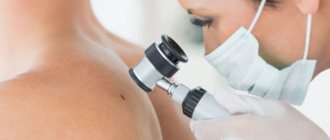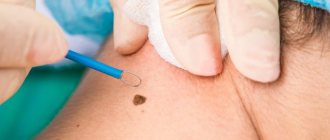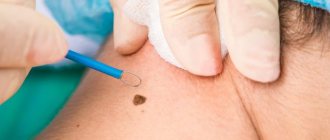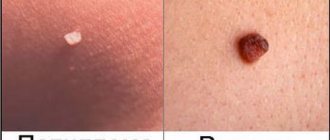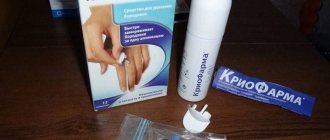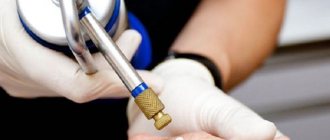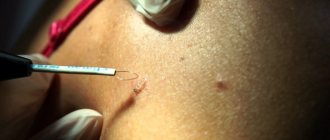From this article you will learn:
- What moles on the face “say”
- Why do they appear
- When is it necessary to remove moles on the face?
- What are the methods for removing moles?
- Why is it best to choose laser removal?
- Where are moles on the face removed in Moscow and how much does it cost?
The body of any person is distinguished by certain “marks”, which are known in everyday speech as moles, and in medicine they are called “nevi”. As a rule, a mole does not bother a person, but there are situations when it still needs to be removed. Such cases include situations when, for example, a mole is on the face, which, firstly, does not add an aesthetic component to the face, and, secondly, increases the risk of accidental skin injuries while washing or wiping with a towel.
What do we know about moles?
What we have always heard about moles: “Does it bother you? Live in peace, don’t touch your mole!” This advice, which was very common in the past, convinced us that moles that were originally given by nature or that appear over the years should remain inviolable. If you touch it, you won’t be able to avoid trouble. This is partly true - indeed, removing moles can lead to the most dire consequences. But in fairness, it should also be noted that not every mole needs to be removed. The most harmless - flat moles
(pink to dark brown).
Usually they behave “quietly”, do not get injured and do not create inconvenience. The only thing you need to remember is to protect such moles (on open areas of the body) from sunlight. Convex moles
, especially if they are often touched by clothing, need to be treated more carefully. If they are on the back and in other places inaccessible to your view, you should entrust someone close to you with monitoring them. And, of course, if any changes occur—the mole becomes larger, turns from flat to convex, or changes its shape—you should immediately contact a specialist.
Stages of healing
The first stage of healing lasts the first seven days, during which the crust gradually darkens and becomes more rigid. You should never touch it, as it protects the wound from infection and promotes the appearance of new healthy tissue. In the first week after the procedure, the operated area should be protected from any injuries and damage; it should not be covered with clothing too often, wetted with water or rubbed with a washcloth, scratched or applied with any cosmetics.
The use of disinfectants is allowed if they have been prescribed by a doctor. You can also treat the crust with a mild solution of potassium permanganate.
The next stage of healing includes the second week after surgery. During this time, the dark crust at the site of the former mole disappears on its own, and light pink skin remains instead. It is still recommended to protect this area from any excessive exposure as well as ultraviolet rays. To this end, it is worth reducing the time spent in the open sun, as well as treating the skin with sunscreen with a maximum protective factor (about SPF 50). Young skin can become significantly pigmented when exposed to the sun, especially on the face.
The final stage of recovery lasts 14 to 20 days after surgery or more. By this time, completely healthy skin has formed at the site of the removed mole, which has protective factors from ultraviolet radiation and other external influences, including mechanical ones. A slight itching may persist, which can be relieved with soothing ointments. Otherwise, skin surface care is no longer required.
If a hole remains at the site of the removed lesion, do not worry: usually the skin smoothes out on its own over the next 1-2 months.
No independence.
Some people believe that you can remove moles yourself by tying them, for example, with silk thread. This is a deep misconception. Attempts to bandage warts and papillomas with a thin silk thread often only provoke the growth of these formations. Today, there are celandine-based preparations on sale that are intended to eliminate warts. But it is better not to remove moles, papillomas, or warts yourself by any means. Celandine juice is similar in composition to iodine, so prolonged exposure to the drug causes skin burns. Cauterization with iodine is even more dangerous - it is more aggressive than celandine. Trying hard to get rid of papillomas with iodine, you can get scars on the skin. Only a dermatologist can properly remove a mole.
Preparations with a cauterizing effect
Pharmacological companies create various effective and affordable drugs for removing tumors at home. Cauterizing remedies for papillomas help get rid of growths forever. The following drugs can be purchased at the pharmacy:
- “Verrucacid.” It is an oily liquid whose main ingredient is phenol. The substance is quite aggressive. The liquid should be applied with an applicator exclusively to the neoplasm. Care must be taken to ensure that the product does not come into contact with healthy tissue. “Verrukatsid” is applied twice with an interval of five minutes. Usually one procedure is enough. The drug is contraindicated for the treatment of pregnant women and children under the age of seven.
- "Ferezol". This drug has a bactericidal and cauterizing effect. The liquid is applied pointwise, several times over the course of an hour. The procedure is repeated after eight days.
- "Solcoderm". This medicine contains oxalic, nitric, acetic and lactic acid. It is recommended to use the drug under the supervision of a specialist with higher or secondary medical education. “Solcoderm” is applied several times pointwise until the neoplasm takes on a yellowish or gray-white color.
Removal methods.
Removal of moles and warts
- Cost: 2,000 rub.
More details
Mole removal can be carried out using a laser, radio wave coagulation or electrical coagulation. These manipulations are performed on an outpatient basis under local anesthesia. The choice of treatment method is determined by the doctor in each specific case. In my opinion, the most effective and painless method is radio wave coagulation. We use this technique in most cases, although in some cases we use excision with conventional surgical instruments followed by suturing. When using radio wave coagulation, tissue damage during material collection will be minimal, blood loss is reduced, and the rehabilitation period is shortened, while, for example, with the laser method, the healing process is extended over a fairly long period. Repeated formations do not appear after removal, but if precautions are not followed by the patient himself, infection may occur.
Where to remove a mole, polyp, condylomas, papilloma or wart in St. Petersburg
At the Diana St. Petersburg Medical Center, all methods of removing tumors are used, but preference is given to modern laser and radio wave techniques. The clinic has the latest radio wave apparatus. Treatment is carried out without pain and complications under ideal sterile conditions.
Here you can take tests for oncology and blood clotting, undergo all types of ultrasound, get advice from a urologist, gynecologist, dermatologist and oncologist. All doctors have the highest qualification category and extensive experience.
Unattended moles.
Some types of moles can degenerate into one of the most malignant tumors - melanoma (skin cancer). The initial site of formation of most melanomas is congenital pigment spots and warty moles. How does this dangerous development begin?
For example, after damage, a person only notices how the color of the mole begins to change, it enlarges, cracks, turns into an ulcer, and sometimes into a tumor. Therefore, without panicking, pay attention to the above symptoms, especially the progressive enlargement of the mole and change in its color. If all these symptoms occur, immediately rush to the dermatologist. The unfavorable prognosis of melanoma dictates the need for regular monitoring by a doctor. In addition to irritant factors (ultraviolet radiation, trauma), the development of melanoma can also be caused by genetic and endocrine factors. However, in the first place is, of course, excessive exposure to the sun. Ultraviolet radiation in large doses causes irreversible changes in skin cells, greatly increasing the risk of their degeneration. Light-skinned and fair-haired, red-haired people with blue and gray eyes are most susceptible to the mutagenic effects of sunlight. Those at risk also include those who have a lot of freckles, age spots and moles.
FAQ:
Is pain relief used?
Pain relief is not used for all types of interventions. For example, cryodestruction, radio wave and laser removal of moles occur in the most gentle way, and doctors do not recommend resorting to anesthesia. Electrocoagulation is also a relatively painless method that does not always require anesthesia.
Anesthesia will definitely be required during classical surgery, when not only the mole is excised, but also part of the tissue. In this case, patients will be given local anesthesia.
How dangerous are moles and their removal from an oncological point of view?
In most cases, moles do not degenerate into a cancerous tumor if they initially do not show signs of malignancy. However, the prerequisites for this may be frequent trauma to the mole and exposure to sunlight.
Dermatoscopy can detect signs of cancerous degeneration:
- uneven edge;
- uneven color;
- bleeding;
- peeling of the neoplasm, cracking;
- fast growth;
- the appearance of compactions and nodular inclusions.
The doctor will give a referral for histology and, when the diagnosis is confirmed, will definitely recommend removing the moles so that they do not lead to cancerous lesions of the skin.
Why is it worth removing a suspicious mole rather than observing it? Statistics show that skin cancer in every third patient develops from a malignant mole, and in 70% the disease is disguised as melanoma.
75% of skin cancer cases are fatal, and at stage 4 the mortality rate is 90%. Do not delay visiting a doctor if a suspicious tumor appears. Removing an aggressive mole is the only chance to get rid of the problem at an early stage.
What are the restrictions for deletion?
Doctors do not recommend removing moles for children. The procedure is possible according to indications in patients over 12 years of age if the mole is in the way and is often injured.
In case of aesthetic dissatisfaction, it is better to remove moles from people over 18 years of age. There are no restrictions on the number of moles removed at one time.
To make an appointment for mole removal in Moscow, call the phone number on the website and contact the administrator: he will agree on dates convenient for you and make an appointment with the doctor, where a specialist will examine the mole and advise on the cost of the procedure according to the price list.
Dangerous sun.
For each person, the critical duration of exposure to sunlight is highly individual. It’s not easy to determine this line, so it’s better to just remember that prolonged exposure to the sun is harmful to the body. The skin is forced to protect itself from ultraviolet radiation. Excessive tanning means inevitable burns. If you love beach holidays so much that you simply cannot deny yourself this pleasure, at least listen to the following tips. By following these simple recommendations, you will not only improve your health, but also reduce the risk of a dangerous disease.
- Staying in the sun is safe from morning until 10 o'clock, in the evening after 17 o'clock.
- For people with a large number of moles, it is better to reduce their exposure to the sun.
- Try to avoid redness and sunburn on your skin. If this happens, spend 2-3 days in the shade.
- After swimming in the sea, be sure to rinse your skin with fresh water.
- Even young and healthy people can spend no more than one and a half to two hours a day in the sun.
- Taking certain medications increases the skin's sensitivity to light. Please consult your GP before going on holiday.
- Use sunscreen cosmetics: at the beginning of the holiday, the indicator should be maximum, about 40 units.
- Do not use decorative cosmetics, deodorants and perfumes on the beach - they can cause the appearance of age spots on the skin.



